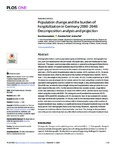Population change and the burden of hospitalization in Germany 2000–2040: Decomposition analysis and projection
Nowossadeck, Enno
Prütz, Franziska
Teti, Andrea
Demographic factors, such as population aging and shrinkage, and non-demographic factors, such as hospitalization rate and length of hospital stay, generate challenges for inpatient care. This paper used decomposition analysis to assess how changes in these factors affected the number of hospital treatment days from 2000 to 2015 in Germany. Demographic aging was linked to increases in the number of treatment days for women (+10.0%) and men (+19.2%) and in hospitalization rates for women +6.0% and men +5.4%. However, these increases were offset by decreases in the number of hospital days (women: 16.5%; men: 7.3%) and length of stay (women: -27.4%; men -26.3%). For the projection up to 2040, 12 scenarios were developed (six for women and six for men) using three variants for future population demographics and two variants for future length of stay and hospitalization rates. One of the two variants for future length of stay and hospitalization rates provides for a constant value for the year 2015. For the second of these two variants variant, a logarithmic model was estimated on the basis of values from 2000 to 2015. and the trends were extrapolated using this model until 2040. The strongest overall predicted increase was 18.4% between 2015 and 2040, including a 22.4% increase for men. In two scenarios for women, only slight declines were predicted. All results, both for the decomposition analysis and projection, indicated a moderate but sustained effect of demographic aging on the number of hospital treatment days, leading to a significant increase in hospital treatment days over the study period. Non-demographic factors also had strong influences, especially in shorter time periods, but these effects offset each other over time. The change in the population size in the period under study had very little effect on the number of hospital treatment days.
Files in this item

